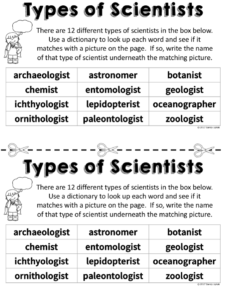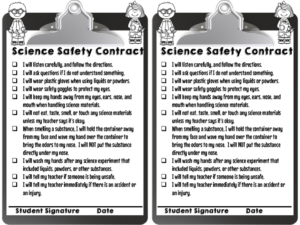Want a fun activity to do with your kids on the first week of school?
Then this Introduction to Science activity is just the thing!
 It’s hard to believe, but I’ve been out of the 3rd grade classroom for 8 years now! Don’t get me wrong, I absolutely LOVE being a librarian. But…every now and then I’ll be talking to my teacher friends or collaborating with them on a project, and will start remembering the activities I used to do with my own students. This always makes me feel a little melancholy (but don’t worry, this story has a happy ending!)
It’s hard to believe, but I’ve been out of the 3rd grade classroom for 8 years now! Don’t get me wrong, I absolutely LOVE being a librarian. But…every now and then I’ll be talking to my teacher friends or collaborating with them on a project, and will start remembering the activities I used to do with my own students. This always makes me feel a little melancholy (but don’t worry, this story has a happy ending!)
This happened recently at the end of this past school year. I was weeding books out of my library, and came across The Button Box by Margarette S. Reid. (You can see the book here on my affiliate link). Two of my 3rd grade teachers came into the library at that same time, and I asked them if they wanted the weeded book. I explained to them how I used it at the beginning of the year along with an “Introduction to Science” activity.

If you’re a teacher, you know that the first week of school is typically spent doing all kinds of team building activities, along with practicing routines over and over again. What I found most helpful in transitioning into the 2nd week was finding ways to maintain our normal schedule even throughout the first week of school. I would make sure that my students would do a math activity during math time, science activity during science, reading activity during reading, ….you get the point! 🙂 Most often, the activities would be shorter with extra time built in for setting expectations, team building and/or cooperative games, and then debriefing afterwards.
That’s why I originally created this Introduction to Science activity. I wanted to give my students an opportunity to start thinking about science while having fun doing hands-on activities that first week of school. It also allowed me to introduce some basic science concepts and give my kids a chance to use their science skills in short activities. The two 3rd grade teachers were excited about this activity, so I spent a few days updating my old ClarisWorks file (Wow! Anyone else remember Apple’s old word processing program? 😳 LOL!)
Before I Begin, You Have to Know…
**I absolutely DETEST loose papers…So almost everything I made turned into a “packet” that was hole-punched and stapled and kept in my students’ Daily Binder. Whenever it was Science time, my students would take their packet out and turn to whatever page we were working on that day. I also found it was harder to misplace a packet, versus a single sheet of paper.
**I always used some sort of “treasure box” system in my class. I used to purchase these small, white, 6 1/2 in square boxes at the Container store. I gave a box to each student, and had them decorate it with sharpies and/or stickers as their “3rd grade memory box”. Throughout the year, I would give them small items to put in their box as a reminder of an activity or an event that we all shared. During our student-led conferences, my students would go through the box and pick out 3-4 items to talk to their parents about and share their memories of third grade. At the end of the year, they would get to take the box home.
**Even though I used this activity with my 3rd graders, I really think it can be used with 2nd, 4th, and 5th graders as well.
Here’s an updated look at this activity!
Day #1: I had the kids describe and draw what they envisioned when hearing the word “Scientist”. This is always a great way to see what their preconceived notions are, and see how (and if) they viewed themselves as a Scientist. Then we would read the book What Are Scientist by Rita Golden Gelman. (You can see the book here at my affiliate link.)


Day #2: We continued to explore different types of scientists. I created two versions of this activity. One has students looking up words in a dictionary to find their meaning. Some classes were okay doing this, but other classes this was too hard of an activity at the beginning of the year.


So, I created a Puzzle Game that I copied on different colored cardstock. I cut apart the pieces and put them in an envelope. I made 10 copies of this, so that kids could work in groups to solve the puzzles. Once they had the puzzles solved, they could use the definitions to fill in the answers. (Be prepared..this activity can sometimes last longer than one day. Kids inevitably asked “Are those the only types of scientist?” which would lead us to research using databases and/or encyclopedias to learn more.)


Day #3: We used this day to explore different tools that scientists use as part of their job. I always had samples of a variety of tools out, and gave kids time to explore them up close before we started on the pages. We also used this day to go over the 5 senses, another type of “tool” that scientists use all the time.


Day #4: By this time, the kids were sooo ready to actually “be a scientist”, you could feel it! I gave them each a magnifying glass and a penny to observe. We talked about the difference between factual statements and opinions, and made a list of opinion words to avoid using in their observations. (They then put their penny in their treasure box as a reminder of this activity.)

Day #5: We ended the week talking about how scientists classify (group/sort) items based on characteristics/traits. I let each student select their own “special bead” out of my bead jar to observe. After they wrote down observations of their bead, I gave them an additional 5 or 6 beads to sort. (They then chose ONE bead to keep in their treasure box as a reminder of this activity.)

Day #6: We started the next week out by reading the book, The Button Box. Then, I let them pick out a button from my button jar. (I collected buttons for the longest time, and would always be on the lookout for really cool and funky ones to add to my collection.) They would practice writing observations and then I would give them a handful of buttons to practice sorting. (They then chose ONE button to keep in their treasure box as a reminder of this activity.)

For the rest of the week, I had them working on their first writing prompt of the year. I told them to look at their special button and imagine the adventures of their button (like the stories of the buttons in the book The Button Box). They had to include a detailed description of their button, and explain the history of how that button came to be in my button jar in order for them to select it for this activity. (These stories were always so much fun to read! Plus it gave me a beginning of the year writing sample that I could use as a pre-assessment of their writing skills.)
The last thing we did was talk about how important it is to be safe in science class. I gave each student a copy of the Science Safety Contract, and we went over it together in class. Each student had to agree and sign the contract before any additional experiments could be conducted in class. We kept these contracts in our Daily Binder as a reminder and would read the expectations over each time we were getting ready to do another experiment. (As a final memory to this activity, I gave them each a small plastic magnifying glass to put in their treasure box.)

Well, that’s it in a nutshell! LOL! If you’re interested in doing this activity with your kids, at home or in the classroom, you can find it here on my website.
I hope you find this useful!

Don’t forget to let me know how it goes if you try it out in your classroom!









Resources for librarians, teachers, parents, & grandparents